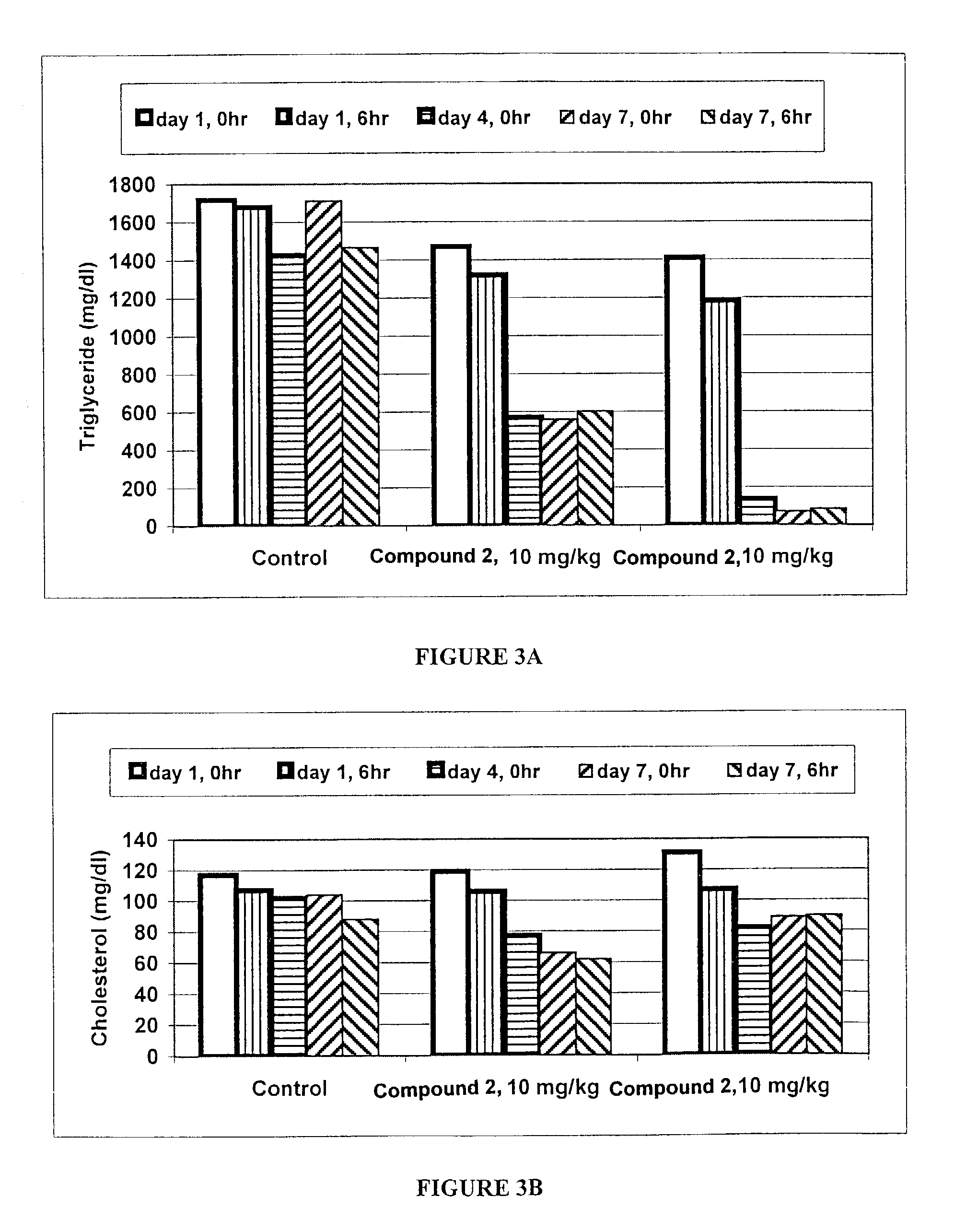Methods of treatment during vascular procedures
a technology of vascular procedures and treatment methods, applied in the field of medicine, can solve the problems of ischemia or necrosis, characteristic clinical sequelae, lack of oxygen, etc., and achieve the effect of lowering serum triglycerides
- Summary
- Abstract
- Description
- Claims
- Application Information
AI Technical Summary
Benefits of technology
Problems solved by technology
Method used
Image
Examples
example i
Synthesis of Compound 1
[0195]Compound 1 has the following chemical structure:
[0196]
[0197]Compound 1, 4-[[4-(4-ethylphenyl)-2,2-dimethyl-(2H)-thiochromen-6-yl]-ethynyl]-benzoic acid, can be synthesized using conventional organic synthetic methods. A method for synthesizing Compound 1 is described below.
[0198]Step 1: A heavy-walled screw cap tube was charged with 3-methyl-2-butenoic acid (13.86 g, 138.4 mmol), 4-methoxy thiophenol (20.0 g, 138.4 mmol), and piperidine (3.45 g, 41.6 mmol). This mixture was heated to 105° C. for 32 hours, cooled to room temperature and dissolved in ethyl acetate (EtOAc) (700mL). The resulting solution was washed with 1M aqueous HCl, H2O, and saturated aqueous NaCl before being dried over Na2SO4. Concentration of the dry solution under reduced pressure afforded an oil which, upon standing in the freezer, provided a crystalline solid. 3-(4-methoxy-phenylsulfanyl)-3-methyl-butyric acid was isolated as pale-yellow crystals by washing the crystalline solid wi...
example ii
Synthesis of Compound 2
[0211]This example describes the synthesis of Compound 2. Compound 2 can be synthesized using conventional organic synthesis methods. A method for synthesizing Compound 2 is described below.
[0212]A synthetic scheme for the synthesis of Compound 2 is shown in FIG. 1. Briefly, commercially available dihydrocoumarin (structure 1 in FIG. 1) was first treated with Grignard reagent (step a: (i) MeMgBr, ether, 0° C.; (ii) conc. H2SO4) to give chroman 2. Chroman 2 was acetylated (step b: AcCl, AlCl3, CH2Cl2, 0° C.) under Friedel-Craft's condition to give ketone 3. Oxidation of ketone 3 with NaOBr (step c: NaOBr, dioxane / H2O) afforded acid 4. Acid 4 was further converted to ester 5 via esterification, bromination and CrO3 oxidation (step d: (i) EtOH, conc. H2SO4, reflux; (ii) Br2, HOAc; (iii) CrO3, Ac2O, HOAc).
[0213]Ester 5 was treated with triflic anhydride and pyridine (step e: Tf2O, pyridine, CH2Cl2, reflux) to derive triflate 6. Triflate 6 was reacted with p-tolylb...
example iii
Treatment of ZDF Rats with an RAR Antagonist / Inhibitor
[0215]This example describes the effect of RAR antagonists / inhibitors on triglyceride and cholesterol levels in female ZDF rats.
[0216]ZDF rats, which are hyperlipidemic and diabetic, were used as a model to test the effect of RAR antagonists / inhibitors on serum lipids. Female ZDF rats (10–11 weeks old) were fed a GMI 13004 diet, a diabetogenic, high fat diet, for 5–6 weeks. Compound 1 was dissolved in vehicle (2% DMSO, 98% corn oil). Compound 1 was administered at a dosage of 0.03 mg / kg, 0.1 mg / kg, and 0.3 mg / kg body weight. Dosings were performed at approximately 8 a.m. Serum was collected at approximately 12 p.m. on the day before dosing (Day 0, 4 hour); the third day of dosing (Day 3, 4 hour); the seventh day of dosing (Day 7, 4 hour); and 24 hours after the last dosing (Day 8, 0 hour). The levels of triglycerides and cholesterol in the serum samples were measured. The results are shown in Table 1 and are illustrated graphical...
PUM
| Property | Measurement | Unit |
|---|---|---|
| body weight | aaaaa | aaaaa |
| temperature | aaaaa | aaaaa |
| temperature | aaaaa | aaaaa |
Abstract
Description
Claims
Application Information
 Login to View More
Login to View More - R&D
- Intellectual Property
- Life Sciences
- Materials
- Tech Scout
- Unparalleled Data Quality
- Higher Quality Content
- 60% Fewer Hallucinations
Browse by: Latest US Patents, China's latest patents, Technical Efficacy Thesaurus, Application Domain, Technology Topic, Popular Technical Reports.
© 2025 PatSnap. All rights reserved.Legal|Privacy policy|Modern Slavery Act Transparency Statement|Sitemap|About US| Contact US: help@patsnap.com



